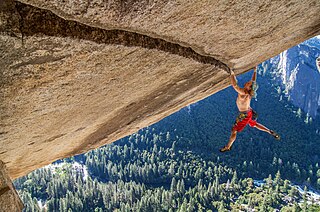
Climbing is the activity of using one's hands, feet, or other parts of the body to ascend a steep topographical object that can range from the world's tallest mountains to small boulders. Climbing is done for locomotion, sporting recreation, for competition, and is also done in trades that rely on ascension, such as construction and military operations. Climbing is done indoors and outdoors, on natural surfaces, and on artificial surfaces
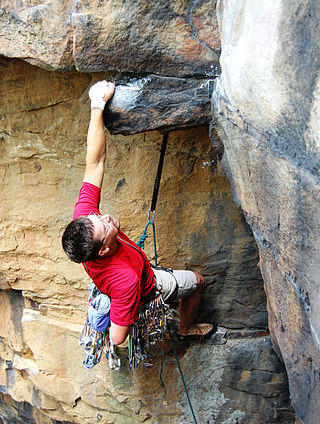
Traditional climbing is a type of free climbing in rock climbing where the lead climber places the protection equipment while ascending the route; when the lead climber has completed the route, the second climber then removes the protection equipment as they climb the route. Traditional climbing differs from sport climbing where the protection equipment is pre-drilled into the rock in the form of bolts.

A climbing route is a path by which a climber reaches the top of a mountain, a rock face or an ice-covered obstacle. The details of a climbing route are recorded in a climbing guidebook and/or in an online climbing-route database. Details recorded will include elements such as the type of climbing route, the difficulty grade of the route–and beta on its crux(es)–and any risk or commitment grade, the length and number of pitches of the route, and the climbing equipment that is needed to complete the route.

Glossary of climbing terms relates to rock climbing, mountaineering, and to ice climbing.

Ice climbing is a climbing discipline that involves ascending routes consisting of frozen water. To ascend, the ice climber uses specialist equipment, particularly double ice axes and rigid crampons. To protect the route, the ice climber uses steel ice screws that require skill to employ safely and rely on the ice holding firm in any fall. Ice climbing routes can vary significantly by type, and include seasonally frozen waterfalls, high permanently frozen alpine couloirs, and large hanging icicles.
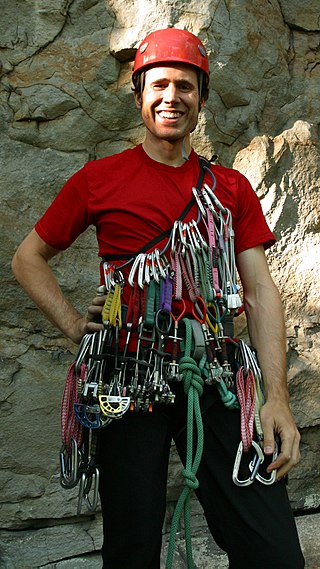
Rock-climbing equipment varies with the specific type of climbing that is undertaken. Bouldering needs the least equipment outside of climbing shoes, climbing chalk and optional crash pads. Sport climbing adds ropes, harnesses, belay devices, and quickdraws to clip into pre-drilled bolts. Traditional climbing adds the need to carry a "rack" of temporary passive and active protection devices. Multi-pitch climbing, and the related big wall climbing, adds devices to assist in ascending and descending fixed ropes. Finally, aid climbing uses unique equipment to give mechanical assistance to the climber in their upward movement.
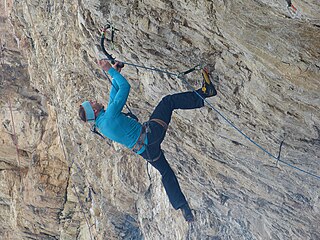
Dry-tooling is a form of mixed climbing that is performed on bare, ice-free, and snow-free, routes. As with mixed climbing, the climber uses ice tools and crampons to ascend the route, but uses only rock climbing equipment for protection; many modern dry-tooling routes are now fully bolted like sport climbing routes. Indoor ice climbing competitions are held on non-ice surfaces and are effectively dry-tooling events.

Sport climbing is a type of free climbing in rock climbing where the lead climber clips into pre-drilled permanent bolts for their protection while ascending a route. Sport climbing differs from the riskier traditional climbing where the lead climber has to insert temporary protection equipment while ascending.
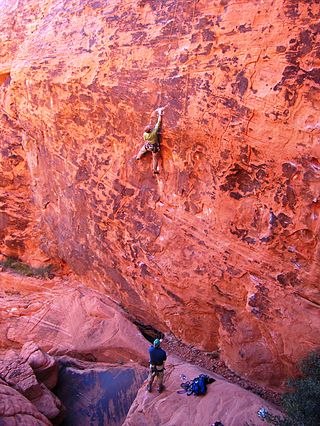
Top rope climbing is a form of rock climbing where the climber is securely attached to a climbing rope that runs through a fixed anchor at the top of the climbing route, and back down to the belayer at the base of the climb. A climber who falls will just hang from the rope at the point of the fall, and can then either resume their climb or have the belayer lower them down in a controlled manner to the base of the climb. Climbers on indoor climbing walls can use mechanical auto belay devices to top rope alone.
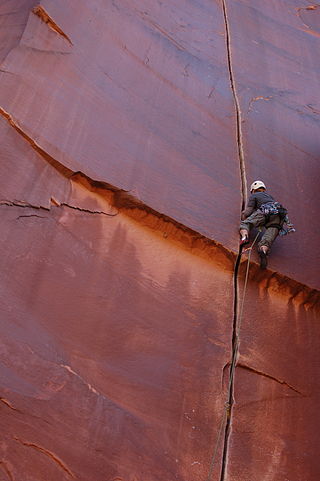
Rock climbing is a climbing sports discipline that involves ascending routes consisting of natural rock in an outdoor environment, or on artificial resin climbing walls in a mostly indoor environment. Routes are chronicled in guidebooks, and on online databases, with the details of how to climb the route, and who made the first ascent and the coveted first free ascent. Climbers will try to ascend a route onsight, however, a climber can spend years projecting a route before they make a redpoint ascent.

Multi-pitch climbing is a type of climbing that typically takes place on routes that are more than a single rope length in height, and thus where the lead climber cannot complete the climb as a single pitch. Where the number of pitches exceeds 6–10, it can become big wall climbing, or where the pitches are in a mixed rock and ice mountain environment, it can become alpine climbing. Multi-pitch rock climbs can come in traditional, sport, and aid formats. Some have free soloed multi-pitch routes.

Johnny Dawes is a British rock climber and author, known for his dynamic climbing style and bold traditional climbing routes. This included the first ascent of Indian Face, the first-ever route at the E9-grade. His influence on British climbing was at its peak in the mid to late-1980s.

Beta is a climbing term that designates information about how to ascend a climbing route, and the specific climbing techniques required—and how to apply them—to overcome the key challenges encountered. Traditionally sourced in climbing guidebooks, online databases and apps now provide detailed climbing beta. The term is attributed to Texan climber Jack Mileski.

In the history of rock climbing, the three main sub-disciplines – bouldering, single-pitch climbing, and big wall climbing – can trace their origins to late 19th-century Europe. Bouldering started in Fontainebleau, and was advanced by Pierre Allain in the 1930s, and John Gill in the 1950s. Big wall climbing started in the Dolomites, and was spread across the Alps in the 1930s by climbers such as Emilio Comici and Riccardo Cassin, and in the 1950s by Walter Bonatti, before reaching Yosemite where it was led in the 1950s to 1970s by climbers such as Royal Robbins. Single-pitch climbing started pre-1900 in both the Lake District and in Saxony, and by the late-1970s had spread widely with climbers such as Ron Fawcett (Britain), Bernd Arnold (Germany), Patrick Berhault (France), Ron Kauk and John Bachar (USA).

Mixed climbing is a climbing discipline used on routes that do not have enough ice to be pure ice climbs, but are also not dry enough to be pure rock climbs. To ascend the route, the mixed climber uses ice climbing equipment, but to protect the route, they use both rock-climbing equipment and ice climbing equipment. Mixed climbing varies from routes with sections of thick layers of ice and sections of bare rock, to routes that are mostly bare rock but which are "iced-up" in a thin layer of ice and/or snow.

In climbing and mountaineering, a traverse is a section of a climbing route where the climber moves laterally, as opposed to in an upward direction. The term has broad application, and its use can range from describing a brief section of lateral movement on a pitch of a climbing route, to large multi-pitch climbing routes that almost entirely consist of lateral movement such as girdle traverses that span the entire rock face of a crag, to mountain traverses that span entire ridges connecting chains of mountain peaks.

In rock climbing, a crack climb is a type of climbing route that follows a system of crack(s) or fissure(s) that the climber uses to ascend the route. The width of the crack dictates the techniques needed, and crack-climbs are further differentiated by the body parts that can be 'jammed' into them, such as finger cracks, hand/fist cracks, arm cracks, and body cracks. Off-width cracks are some of the most awkward, being too wide for the hands or arms, but too narrow to accommodate the body. The rare top-to-bottom uniform-width crack is called a splitter crack.

In rock climbing, an overhang is a type of route that leans back at an angle of over 90 degrees for part or all of the climb, and at its most severe can be a horizontal roof. Overhang climbs have existed throughout climbing, originally in aid climbing where mechanical devices were used to first scale them. They became more common in free climbing during the 1990s as sport climbers used new training methods that enabled them to climb routes that were continuously, and severely, overhanging. Overhangs also feature prominently in advanced bouldering and in competition climbing.

In rock climbing a face climb is a type of climbing route where the rock face is fully vertical, unlike in slab climbing, and is largely featureless, unlike in crack climbing. Face-climbing routes are typically sustained and exposed, and longer multi-pitch face-routes can become big wall climbing. Face-climbing became more common with the introduction of sport climbing in the 1980s, when French climbers began to fix permanent bolts into the rock as climbing protection — in contrast to traditional climbing — allowing them to ascend the blanker rock faces in places like the Verdon Gorge and Buoux in France.
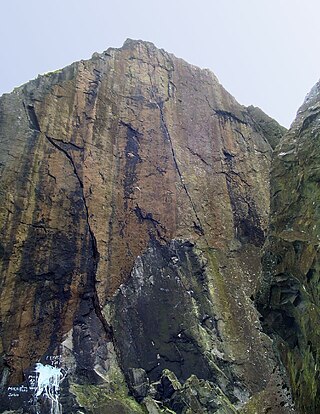
Rhapsody is a 35-metre (115 ft) long traditional climbing route up a thin crack on a slightly overhanging vertical basalt rock face on Dumbarton Rock, in Scotland. When Scottish climber Dave MacLeod made the first free ascent in 2006, it became Britain's first-ever E11-graded route, and at the grade of 5.14c (8c+), Rhapsody was the world's hardest traditional route. It set a grade milestone in traditional climbing that stood for over a decade until the ascent of Tribe at grade E11-12 5.14d (9a) in 2019 and of Bon Voyage at grade E12 5.14d (9a) in 2024.























